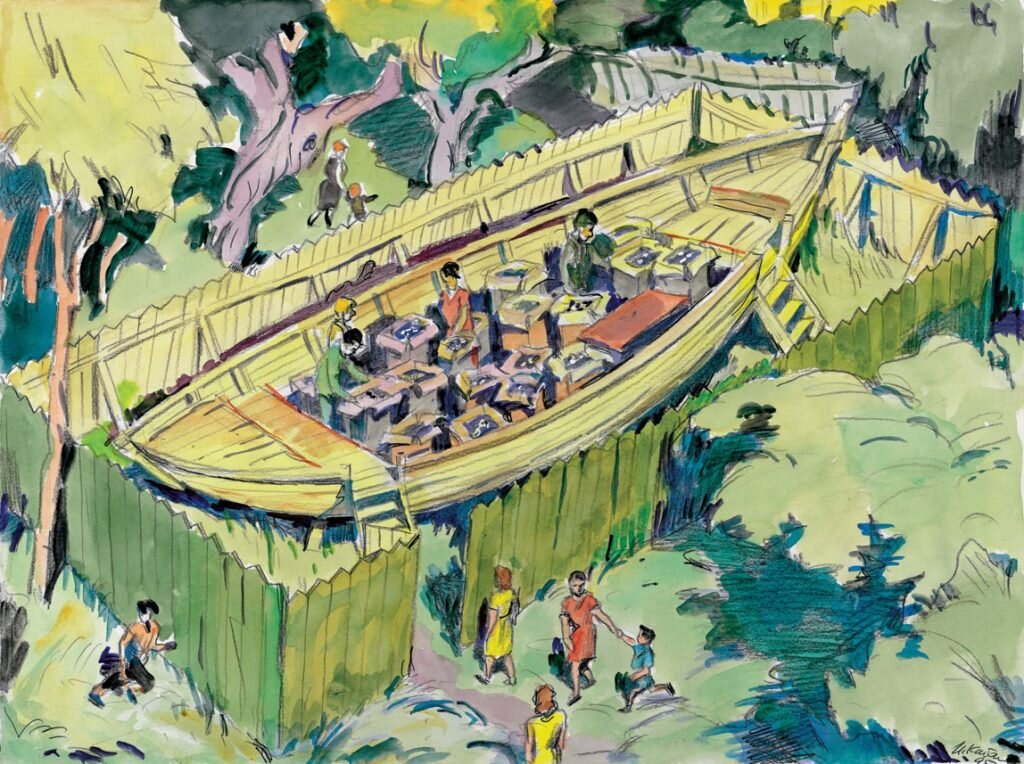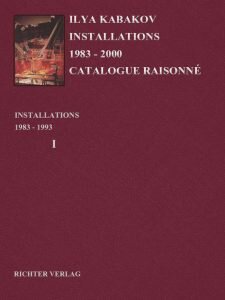The Boat of My Life
YEAR: 1993
CATALOGUE NUMBER: 72
PROVENANCE
The artist
2001, Collection EMET, National Museum of Contemporary Art, Athens, Greece
EXHIBITIONS
Salzburg, Salzburger Kunstverein
Ilya Kabakov. Das Boot meines Lebens, 11 Aug 1993 — 3 Oct 1993
Grenoble, Le Magasin, Centre national d’art contemporain
Le bateau de ma vie. L’album de ma mère. La rivière souterraine dorée, 16 Apr 1994 — 17 Jul 1994
Dresden, Festspielhaus Hellerau (Organization: Euro päische Werkstatt für Kunst und Kultur Hellerau e. V.)
Boot meines Lebens und Nicht ausgeführte Projekte, 15 Jul 1995 — 6 Aug 1995
Greve, Portalen, Køge Bugt Kulturhus
Ilya Kabakov. Storyteller. Installationer og ikke- realiserede projekter, 19 Jan 1996 — 17 Mar 1996
Aalborg, Nordjyllands Kunstmuseum
Ilya Kabakov. Storyteller. Installationer og ikke- realiserede projekter, 14 Apr 1996 — 12 Jun 1996
Urbana- Champaign, Krannert Art Museum
The Boat of My Life. Ilya Kabakov, 17 Sep 1998 — 17 Nov 1998
Durham, Duke University Museum of Art
The Boat of My Life. Ilya Kabakov, 25 Jun 1999 — 17 Oct 1999
Providence, The David Winton Bell Gallery, List Art Center
The Boat of My Life. Ilya Kabakov, 12 Nov 1999 — 31 Dec 1999
Milwaukee, Milwaukee Art Museum
The Boat of My Life. Ilya Kabakov, 20 Jan 2000 — 30 Apr 2000
Aspen, Aspen Art Museum
2 Jun 2000 — 23 Jul 2000
Atlanta, Nexus Contemporary Art Center
1 Sep 2000 — 31 Oct 2000
DESCRIPTION
A large, wooden, virtually ‘real’ boat 17.4 meters in length, 5.5 meters in width and 2.6 m in height (bow and stern) is erected in the exhibition hall. Its deck is horizontal, level. Two ‘shelves’ are raised on its bow and stern. Two sets of stairs lead from the floor to the deck, one for getting on the boat, the other for disembarking. There are special holes cut thorough the sides of the boat for this.
Twenty four cardboard crates, its ‘cargo,’ are arranged inside the boat in a disorderly fashion on the deck. Each crate is open, the packaging is unwrapped, and the viewer can look into the contents of each crate. All kinds of residential junk is heaped there, like what you might see in the case of any move or of sending things somewhere: children’s clothing, toys, dishes, books, more clothing, boots … In the middle of all this, like a list of the contents, there are pieces of cardboard inside the crates with all kinds of junk glued to them: pins, buttons, pencil stubs, newspaper clippings, photographs … Under each object is an inscription in Russian and a translation.
It becomes clear by reading what’s written, that before us is the story of a life represented day after day, year after year, by this collection of objects and inscription-memories under them.
Each crate, as is easily guessed, together with the things contained in it, represent a particular period of that life, and all of them, standing one after another in disarray from the ‘stern to the bow,’ form a ‘material’ history of that very life.
The viewer, ascending from the ‘stern,’ begins to read and examine this history ‘from childhood,’ and moving from crate to crate, he reaches the moment when this installation itself was constructed. He then descends the stairs near the very ‘bow’ of the boat.
CONCEPT OF THE INSTALLATION
The installation represents a combination of two images: a ‘sailing’ boat and the author’s story about his life, beginning with the moment of his birth and continuing until the making of this installation (until the time when he turns 60 years old). His biography is told in a ‘visual-material’ way, usually common in library ‘museums’: various objects describing the person are displayed, explanations are placed under them. All of it together, arranged in cases or on stands, forms a unique corridor, more or less intricately organized, along which the viewer moves from exhibit to exhibit ‘along,’ or more precisely ‘within,’ someone else’s life from beginning to end.
But this labyrinth of exhibits in the Salzburg installation is arranged on the deck of a large boat, and for the viewer who is walking along this ‘labyrinth of life,’ the impression created by his movement inside of it is superimposed upon the sensation of a vessel sailing somewhere. Where?
The answer comes on its own, and the image which emerges is well-known: before us is Charon’s ferry with only one ‘passenger.’ The entire labyrinth as a whole is his life, almost completed, in which there was not a lot that was pleasant and interesting, but which is already gliding along the Styx to the other, dark, opposite side.
ARTIST`S COMMENTS
One of the most fascinating endeavors and states is the following: to be alive, but yet to not really be living – not to participate in all of life, in all of its upheavals, but rather to be living as though ‘later’ and to see this whole life of yours somehow from the sidelines, from some height and even, if possible, even as though it had already been lived, as if you were dead (a strange and desirable combination). Perhaps this is one of the lightest, most marvelous states: without any emotion whatsoever, without pain, exhaustion and the unknown in front of you, to see everything, to hover above everything, and (what is most important) to be relieved of your uncertain and long life in which you are sure of nothing and where you don’t even know whether you are acting of your own free will or whether this is all happening at someone else’s behest. But being dead already, you see your life in its entirety. You can freely fly from one end to the other and back again, similar to some light, noiseless flying machine that is rushing toward the origins of the river, to its mouth. You are able to hang above any spot along this river, to descend lower, lower, and very low to the window of any house on the bank of this river and peer in … Then you can suddenly take off again and rush quickly along the riverbends, along the river where the real ‘I’ is floating, not knowing and fearing what might turn out to be around the next bend, feeling a constant fear of capsizing on the slippery log that I have been sitting on all my life, not understanding anything inside of me or around me, or, as the landscape floats past, suffocating from terror and being afraid of falling headfirst into the cold water …
And yet, just what does this ‘journey’ along life look like from above, from the light, airy space? Doesn’t it at least in part resemble a long cord lying on the floor, with many twists, loops, and turns? And what about all the events that comprise it? Don’t they appear as dirty scraps of trash tied to it, all identical in their indistinguishability?
Perhaps this viewer is still floating and moving back and forth along this life because someone has arranged this rope of life specially on the floor in front of him for his observation. But then some time will pass, and, having gathered up the rope and the garbage into a single clump, into a tangled knot, it will be shoved into a small sack and carried away, and placed somewhere … But who is this observer? Where is he headed? What will happen to him? It is impossible to say anything about this, because, to tell the truth, he existed only because there was this rope, he was only connected to it, and what will happen to him when they take it away, place it in a package, and carry it off to who knows where?
Images
Literature









